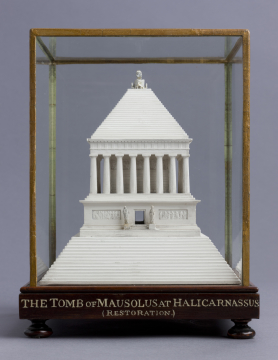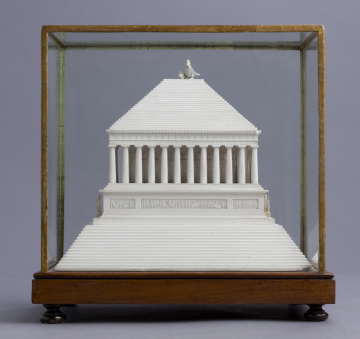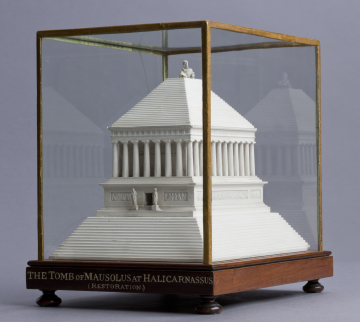Explore Collections


You are here:
CollectionsOnline
/
Model of the Tomb of Mausolus at Halicarnassus, 'restored', c.1800-1834
Browse
François Fouquet (1787 - 1870), maker
Model of the Tomb of Mausolus at Halicarnassus, 'restored', c.1800-1834
Plaster of Paris
Height: 25cm
Width: 19.2cm
Depth: 25.3cm
Width: 19.2cm
Depth: 25.3cm
Museum number: MR37
On display: Model Room (pre-booked tours only)
All spaces are in No. 13 Lincoln's Inn Fields unless identified as in No. 12, Soane's first house.
For tours https://www.soane.org/your-visit
Curatorial note
The Tomb of Mausolus or 'Mausoleum' at Halicarnassus was one of the Seven Wonders of the ancient world listed by the Greek poet Antipater of Sidon. The building was described by the later Roman writer Pliny the Elder (d.79 AD) in Book XXXVI of his Natural History where he describes the decorative scheme by the sculptors Scopas, Bryaxis, Timotheus and Leochares that adorned the Mausoleum.
Pliny explains that the Mausoleum was:
…the tomb that was built by Artemesia for her husband [and brother] Mausolous, the Viceroy of Caria, who died in the second year of the 107th Olympiad [actually 353 BC]. These artists were chiefly responsible for making the structure one of the Seven Wonders of the World. On the north and south sides it extends for 63 feet, but the length of the façade is less, the total length of the façades is less, the total length of the façades and sides being 440 feet. The building rises to a height of 25 cubits and is enclosed by 36 columns…the east side was carved by Scopas, the north by Bryaxis, the south by Timotheus and the west by Leochares; and before they completed their task, the Queen died. However, they refused to abandon n the work without finishing it, since they were already of the opinion that it would be a memorial to their own glory and that of their profession and even today they are considered to rival each other in skill. With them was associated a fifth artist. For above the colonnade there is a pyramid as high again as the lower structure and tapering in 24 stages to the top of its peak. At the summit there is a four-horse chariot of marble, and this was made by Pythis. The addition of this chariot rounds off the whole work and brings it to a height of 140 feet.
It is possible that the tomb stood relatively intact until the medieval period when an earthquake is thought to have finally toppled it. The remains were incorporated into the Castle of St Peter that stood in Bodrum (ancient Halicarnassus). Archaeological exploration of the site was only undertaken in the mid-nineteenth century, so artists such as François Fouquet relied upon Pliny’s written description of this ancient wonder. Fouquet has shown the tomb as a Doric building on a high, stepped podium. The upper part of the podium is decorated with conventionalised, miniature bas-reliefs that are intended to evoke the sculptures of Scopas, Bryaxis, Timotheus and Leochares. This base then supports the Doric peristyle and central cella around which another frieze has been depicted by Fouquet again evoking the sculptures which made it one of the Seven Wonders of the World. Presciently, these show a battle scene. Although Pliny does not describe the subject matter of the friezes, sections discovered in 1846 by Sir Stratford Canning, British Ambassador to Constantinople (Istanbul), show that they depicted the Amazonomachy or Battle of the Amazons. Above the Doric peristyle, Fouquet has followed Pliny’s description and his model includes the twenty-four-stage pyramid crowned by an evocation of Pythis’ sculptural group of Mausolos and a quadriga.
Pliny explains that the Mausoleum was:
…the tomb that was built by Artemesia for her husband [and brother] Mausolous, the Viceroy of Caria, who died in the second year of the 107th Olympiad [actually 353 BC]. These artists were chiefly responsible for making the structure one of the Seven Wonders of the World. On the north and south sides it extends for 63 feet, but the length of the façade is less, the total length of the façades is less, the total length of the façades and sides being 440 feet. The building rises to a height of 25 cubits and is enclosed by 36 columns…the east side was carved by Scopas, the north by Bryaxis, the south by Timotheus and the west by Leochares; and before they completed their task, the Queen died. However, they refused to abandon n the work without finishing it, since they were already of the opinion that it would be a memorial to their own glory and that of their profession and even today they are considered to rival each other in skill. With them was associated a fifth artist. For above the colonnade there is a pyramid as high again as the lower structure and tapering in 24 stages to the top of its peak. At the summit there is a four-horse chariot of marble, and this was made by Pythis. The addition of this chariot rounds off the whole work and brings it to a height of 140 feet.
It is possible that the tomb stood relatively intact until the medieval period when an earthquake is thought to have finally toppled it. The remains were incorporated into the Castle of St Peter that stood in Bodrum (ancient Halicarnassus). Archaeological exploration of the site was only undertaken in the mid-nineteenth century, so artists such as François Fouquet relied upon Pliny’s written description of this ancient wonder. Fouquet has shown the tomb as a Doric building on a high, stepped podium. The upper part of the podium is decorated with conventionalised, miniature bas-reliefs that are intended to evoke the sculptures of Scopas, Bryaxis, Timotheus and Leochares. This base then supports the Doric peristyle and central cella around which another frieze has been depicted by Fouquet again evoking the sculptures which made it one of the Seven Wonders of the World. Presciently, these show a battle scene. Although Pliny does not describe the subject matter of the friezes, sections discovered in 1846 by Sir Stratford Canning, British Ambassador to Constantinople (Istanbul), show that they depicted the Amazonomachy or Battle of the Amazons. Above the Doric peristyle, Fouquet has followed Pliny’s description and his model includes the twenty-four-stage pyramid crowned by an evocation of Pythis’ sculptural group of Mausolos and a quadriga.
Sir John Soane purchased the twenty models by François Fouquet in 1834 from the architect Edward Cresy (1792-1858) who, from 1829 to 1835, worked in Paris. Soane paid Cresy the substantial sum of £100 (£10,136.78 in today’s money). It is likely that Cresy purchased the models directly from Fouquet et Fils.
Exhibition history
Soane and Death, Dulwich Picture Gallery, London, 26 February - 12 May 1996
Wonders of the Ancient World: François Fouquet's Model Masterpieces, Sir John Soane's Museum, London, 15 July - 22 November 2011
Wonders of the Ancient World: François Fouquet's Model Masterpieces, Sir John Soane's Museum, London, 15 July - 22 November 2011
Soane collections online is being continually updated. If you wish to find out more or if you have any further information about this object please contact us: worksofart@soane.org.uk







